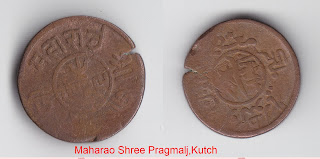Early English settlements in India had three broad grouping: those in Western India (Bombay & Surat), those in South India (Madras) and those in the Eastern Province of Bengal (Calcutta). Early English coins accordingly developed along three broad strands in consonance with the local acceptability of the coins for the purposes of trade.
The coins of Bengal were developed along the Mughal pattern, those of Madras were struck along South Indian lines both in design and metrology(Pagoda) as well as along Mughal design.
By the early 1830, the English had become the dominant power in India. The rise of one dominant power after over a hundred years of turmoil, enabled the enactment of the Coinage Act of 1835 and for uniform coinage to be issued.The coins issued after 1840 bore the portrait of Queen Victoria. The first coinage under the crown was issued in 1862 and in 1877 Queen Victoria assumed the title the Empress of India.
Edward VII succeeded Queen Victoria and the coins issued bore his effigy. The Indian Coinage Act, 1906 was passed which governed the establishment of Mints as well as the coins that would be issued and the standards that would be maintained (Rupee 180 grains, Silver 916.66 standard; Half Rupee 90 grains, Quarter Rupee 45 grains). George V succeeded Edward VII. Acute shortage of silver on account of World War I, led the British Government to issue paper currency of One Rupee and Two and a half Rupees. The silver coins of smaller denominations were issued in cupro-nickel. George V was in turn succeeded by Edward VIII. However no coins were issued during his short reign. Geroge VI ascended the throne in 1936. The compulsion of the Second World War led to experiments in coinage where the standard rupee was replaced by the "Quaternary Silver Alloy". The Quaternary Silver coins were issued from 1940. In 1947 these were replaced by pure Nickel coins.
Kutch or Cutch Flag/Arms
Salute : 17-guns
Kutch Currency : One Kori = 2 Adhiyo = 4 Payalo = 8 Dhabu = 16 Dhinglo = 24 Dokda = 48 Trambiyo = 96 Babukiya.
5 Kori, Shree Khengarji, Silver, Kutch,
2-1/2 Kori, Shree Khengarji, Silver, Kutch,
1 Kori, Shree Khengarji, Silver, Kutch,
1 Kori, Shree Khengarji, Silver, Kutch,
1/2 Kori, Shree Khengarji, Silver, Kutch,
"Adhiyo", 1/2 Kori, Shree Vijayraj ji, Kutch, copper
"Dhabu", Shree Vijayraj ji, Kutch
"Dhinglo", 1/16 Kori, Copper Shree Vijayraj ji, Kutch
"Payalo", 1/4 Kori, Copper, Shree Vijayraj ji, Kutch
"Trambiyo", 1/48 Kori, Copper, Shree Vijayraj ji, Kutch
JUNAGARH/JUNAGADH FLAG/ARMS
One Dolado, VS 1964, Junagadh,
One Dolado, VS 1964, Junagadh,


























No comments:
New comments are not allowed.